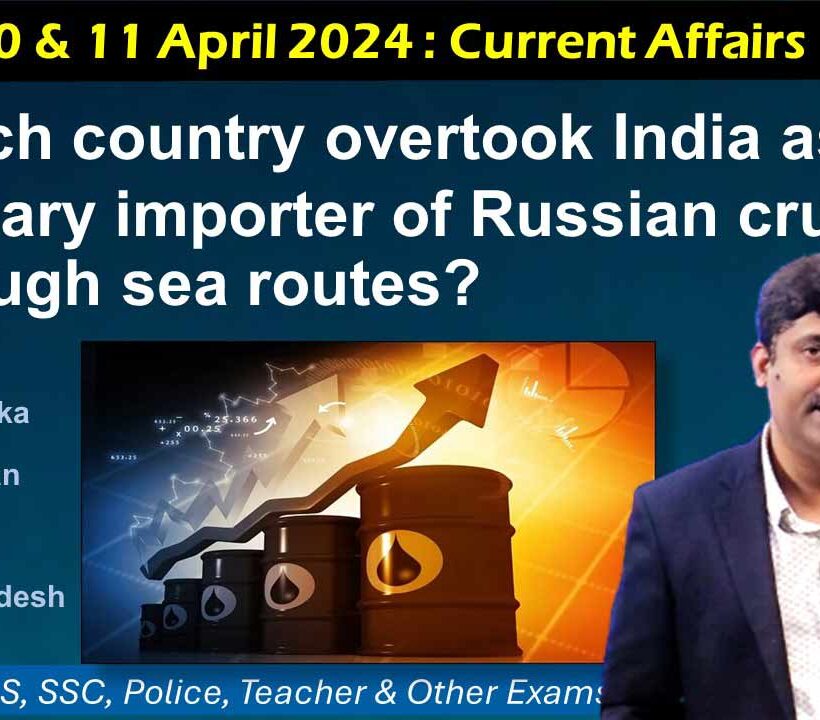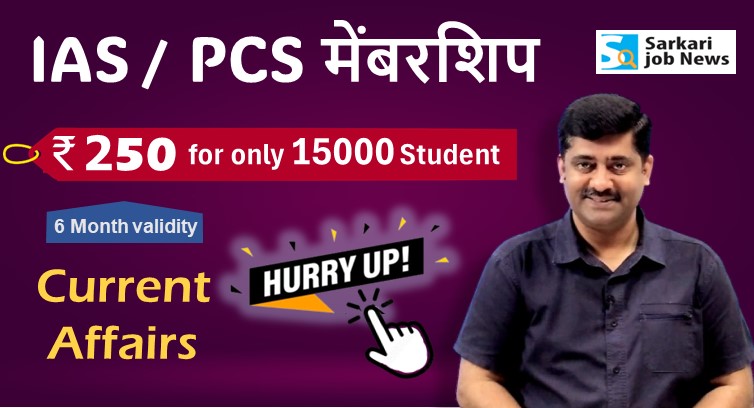This is the current affairs of 10 & 11 April 2024. Here are questions and answers of daily current affairs for better preparation of competitive exams for government jobs.
PDF Download: Click here
1. According to WHO’s Global Hepatitis Report 2024, where is India in the world in terms of this disease?
a. First
b. Second
c. Third
d. Eighth
Answer: b. Second
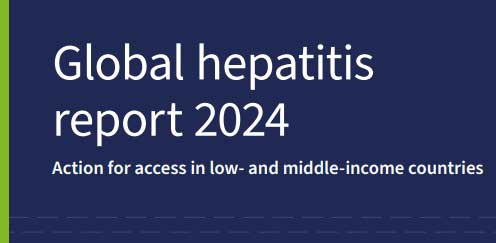
In which country how many cases
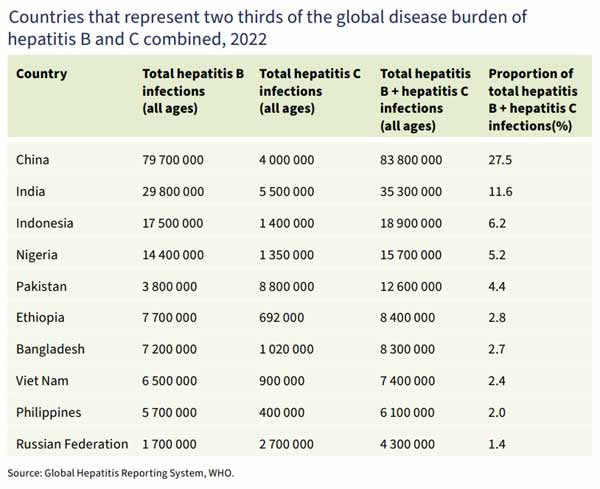
Global Hepatitis Report 2024 on India’s Situation
– India ranks second among countries with the highest burden of viral hepatitis.
– There are 29.8 million patients of Hepatitis B and 5.5 million of Hepatitis C.
– In the year 2022, there were over 50,000 new cases of Hepatitis B and 140,000 new cases of Hepatitis C.
– These infections led to the death of 123,000 people in India in 2022.
– With approximately 1.3 million deaths annually, viral hepatitis claims lives equivalent to tuberculosis (TB).
What is Hepatitis Disease?
– Hepatitis A, Hepatitis B, and Hepatitis C are liver infections caused by three different viruses.
– While their symptoms can be similar, they spread differently and affect the liver in various ways.
– Hepatitis A is usually a short-term infection.
Hepatitis B and Hepatitis C can also start as infections, but in some people, the virus persists, leading to long-term or lifelong infection. Chronic infection can cause liver damage known as cirrhosis and increases the risk of liver cancer.
– Vaccines are available for Hepatitis A and Hepatitis B, but there is no vaccine for Hepatitis C. However, Hepatitis C can be cured.
– Patients with Hepatitis B infection need to take medication for life, while treatment for Hepatitis C lasts for 12 to 24 weeks.
How Hepatitis A Infection Spreads
– Hepatitis A virus spreads through contaminated food or water consumed by an infected person. This is called the fecal-oral route. It happens through contaminated water or food, poor sanitation, and inadequate personal hygiene.
How Hepatitis B Infection Spreads
– Hepatitis B virus spreads through infected blood, similar to HIV.
– During childbirth from mother to child.
– Through infected blood not properly screened.
– During contact with infected blood.
– Among injecting drug users sharing needles.
How Hepatitis C Infection Spreads
– Hepatitis C virus (HCV) spreads through contact of infected blood with blood.
What are the Measures?
– Hepatitis B virus can be prevented through vaccination. If this infection progresses to the stage of chronic Hepatitis B, it is treatable but not curable.
Campaigns Against Hepatitis in India
– Under the Universal Immunisation Programme in India, children are vaccinated against Hepatitis B.
– Treatment for both Hepatitis B and C is available under the program.
————–
2. In which country did the Genocide of 800,000 people occur in the year 1994, in remembrance of which India illuminated the Qutub Minar in the colors of that country’s national flag on April 7, 2024?
a. Germany
b. Rwanda
c. Cambodia
d. Pakistan
Answer: b. Rwanda
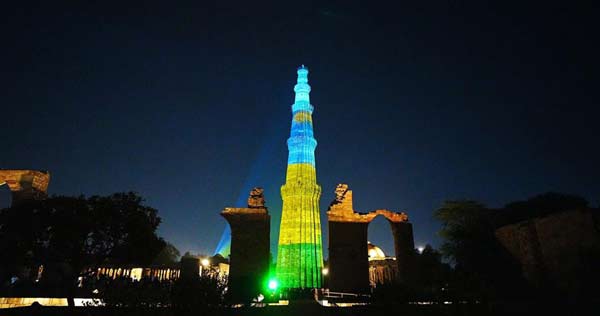
– During this time, Dammu Ravi, Secretary (Economic Relations) at the Ministry of External Affairs, represented India at the 30th Commemoration of the Genocide in Kigali, the capital of Rwanda.
Why was the Kuthub Minar illuminated?
– The Kuthub Minar was illuminated to show solidarity with the people of the East African nation in remembrance of the genocide.
– The minaret was illuminated with the colors of the national flag of Rwanda.
The 1994 Genocide
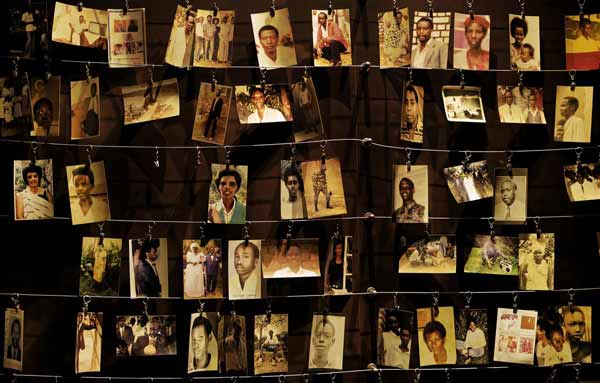
– The year 1994 saw a 100-day genocide.
Nearly 800,000 people lost their lives in it.
– On April 7, 2024, it has been 30 years since this genocide.
– It is counted among the most horrific genocides in history.
– In 2004, the United Nations declared April 7 as the International Day of Reflection.
Secretary’s Visit to Three Countries
– Secretary Dammu Ravi of the Ministry of External Affairs (Economic Relations) is on a tour of Rwanda, Uganda, and Kenya from April 7 to April 12.
– In Rwanda, Secretary Dammu Ravi discussed bilateral issues.
– Additionally, he held meetings with officials from Uganda and Kenya.
About Kuthub Minar
– It is the world’s tallest minaret made of bricks, located in India.
– It is a famous tourist attraction in Delhi.
Qutb-ud-din Aibak started its construction in 1193 AD.
– However, he passed away before its completion.
– It was furthered by Iltutmish, the ruler of Delhi.
– The minaret was named after Qutb-ud-din Aibak.
Rwanda:
– It is a country located in Central-East Africa.
– Its area is approximately 26,000 square kilometers.
– It is even smaller than the Indian state of Kerala.
– Capital: Kigali
– President: Paul Kagame
– Currency: Rwandan Franc
– Population: Approximately 13.8 million (2022)
How did this genocide begin?
– Why did the genocide happen in Rwanda?
It was a tribal conflict between the Tutsi and Hutu communities.
– In the early 1990s, tensions escalated, and in 1994, after the assassination of Rwanda’s then-President Juvenal Habyarimana, Hutu extremists attacked Tutsi minorities.
– This violence quickly turned into widespread genocide, in which Hutu extremists targeted Tutsis and moderate Hutus. During the genocide, soldiers, police, and Hutu militia groups killed millions of people, most of whom were innocent civilians.
– Several months after the genocide, the Tutsi-led Rwandan Patriotic Front (RPF) seized power and stopped the violence.
——————-
3. Which of its neighboring countries is India helping in developing early warning systems regarding weather?
a. Nepal, Maldives
b. Sri Lanka, Bangladesh, Mauritius
c. Myanmar, Bhutan, Afghanistan
d. Both a and b
Answer: d. Both a and b (Nepal, Maldives, Sri Lanka, Bangladesh and Mauritius)

– Mritunjay Mahapatra, the Chief of the India Meteorological Department (IMD), provided this information in April 2024.
– India is assisting these 5 countries in developing an early warning system to reduce loss of life and property due to extreme weather events.
– India will play the role of a big brother and a cooperative advisor to these countries.
Why is India helping?
– According to the India Meteorological Department (IMD), 50% of countries do not have an early warning system.
– These countries include poor nations, least developed countries, and small island nations.
– Due to the lack of an early warning system, people in these countries are suffering significant loss of life and property on a large scale.
– People are dying and losing a lot of property due to disasters.
– Therefore, India is helping some of its neighboring countries in developing an early warning system.
– The 5 countries India is assisting are also poor, least developed, and small island nations.
UN’s Early Warning Campaign:
– The United Nations (UN) initiated the “Early Warning for All” campaign in March 2022.
– The focus of this campaign is to save everyone from hazardous weather, water, or climate events by 2027.
– In the first phase of this initiative, India is assisting five out of 30 countries.
How many countries have early warning systems?
– According to a report released by the World Meteorological Organization (WMO) in December, 101 countries (52%) now have multi-hazard early warning systems.
– The rest of the countries do not have such systems.
– The report indicates a fivefold increase in water-related disasters from 1970 to 2019.
#According to the report, how many deaths and how many people are affected by disasters#
How many deaths occurred between 1970 and 2021?
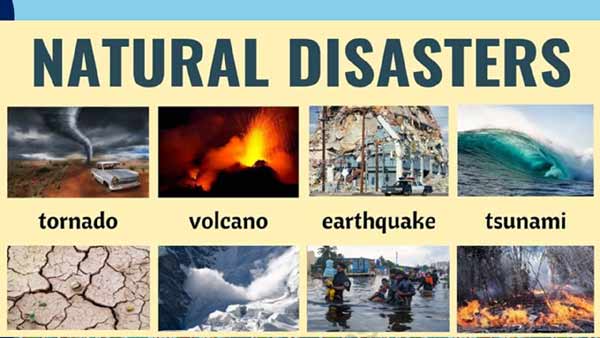
– During this period, approximately 12,000 weather, climate, or water-related disasters were recorded worldwide.
– These disasters resulted in the deaths of around 2 million people and an economic loss of 4.3 trillion dollars.
– Note: Between 2015 and 2022, approximately 41,789 people died due to disasters.
– From 2013 to 2022 in Asia, more than 146,000 people died due to disasters.
– In Asia, over 911 million (approximately 91 crore) people were directly affected.
How many people are affected on a global scale?
– According to The Hindu newspaper, the number of people affected by disasters is increasing.
– Every year, more than 130 million (approximately 13 crore) people are affected at the global level.
Facing large-scale disasters by 2030
– It is estimated that by 2030, the world may face large-scale disasters averaging 560 per year.
– Climate change not only makes disasters more likely but also complicates response efforts.
India Meteorological Department (IMD)
– Chief: Mrutyunjay Mohapatra
– Headquarters: New Delhi
– Establishment: January 15, 1875
World Meteorological Organization (WMO)
– It is a meteorological organization.
– Establishment: March 23, 1950
– Headquarters: Geneva, Switzerland
– President: Abdullah Al Mandous
—————-
4. Which country overtook India as the primary importer of Russian crude oil through sea routes in March 2024?
a. Sri Lanka
b. Pakistan
c. China
d. Bangladesh
Answer: c. China

According to which report proceeded
– According to the Energy Cargo Tracker Vortexa report released in the early days of April 2024, China surpassed India as an importer.
– In March 2024, China imported 1.82 million barrels per day (MBD) of crude oil via sea routes, which is one and a quarter times more than India’s 1.36 MBD.
——————
5. Where will India’s first commercial crude oil strategic storage be built?
a. Visakhapatnam
b. Mangalore
c. Padur
d. Lucknow
Answer: c. Padur
– India is the world’s third-largest consumer and importer of oil.
– China comes second, and the United States ranks first.
– India fulfills over 85 percent of its oil requirements through imports.
– Strategic petroleum reserves are essential in any emergency situation like supply disruption or war.
– India already has three operational strategic petroleum reserves, which can meet approximately 9.5 days of national demand.
– However, a decision has been made to build commercial strategic petroleum reserves.
– The Indian Strategic Petroleum Reserves Limited (ISPRL) manages these reserves.
Strategic Petroleum Reserves in India: 5.33 million metric tons (approximately 53.3 million tons)
1. Visakhapatnam, Andhra Pradesh (1.33 million tons)
2. Mangalore, Karnataka (1.5 million tons)
3. Padur, Karnataka (2.5 million tons)
Commercial Strategic Petroleum Reserves
– ISPRL has invited bids for the construction of an underground storage facility of 2.5 million tons in Padur, Karnataka.
– Commercial strategic petroleum reserve means that a private company will manage it.
What is Crude Oil?
– Crude oil or raw oil is a mixture of hydrocarbons that exists in the liquid phase in natural underground reservoirs and remains liquid under atmospheric pressure after passing through surface separation facilities.
– Crude oil is a component of petroleum, from which approximately 6000 types of products are obtained.
– Crude oil undergoes continuous refining to produce different types of products, which we use daily in various ways.
————–
6. Name the Formula One World Champion who secured pole position (top position) at the Japanese Grand Prix for the third consecutive year?
a. Arlos Sainz
b. Fernando Alonso
c. Sergio Pérez
d. Max Verstappen
Answer: d. Max Verstappen (Red Bull driver)

– Max Verstappen is a racing car driver.
He secured the pole position (top/first place) on April 6, 2024, at the Japanese Grand Prix.
– Verstappen achieved the top spot by clocking a time of 1 minute 28.197 seconds, surpassing his teammate Sergio Perez.
– Nine years after Lewis Hamilton, he becomes the first driver to secure pole position in the opening races of a season.
Pole Position
– In motorsport racing, the top/first position on the starting grid is known as the pole position.
– During the qualifying race, the driver with the fastest time earns the pole position for the upcoming race.
– Starting grid refers to a designated section of the track where cars line up in rows according to their practice times.
– The number one qualifying driver is also referred to as the pole-sitter.
——————
7. Sitar and Tanpura made in Miraj city of which state got GI tag in March 2024?
a. Bihar
b. Gujarat
c. Maharashtra
d. Uttar Pradesh
Answer: c. Maharashtra
– A small town in the Sangli district of Maharashtra, Miraj, is known for the craftsmanship of making musical instruments.
– According to The Hindu newspaper, the Central Government granted GI tags to both Sitar and Tanpura on March 30, 2024.
How old is the tradition of making Tanpura and Sitar?
– The tradition of making Sitar and Tanpura in Miraj is more than 300 years old.
– More than seven generations of craftsmen here have worked towards making these stringed instruments.
Difference between Tanpura and Sitar:
– Tanpura – It is a long-necked, fretless, four-stringed instrument originating in the Indian subcontinent.
– Tanpura resembles a simplified Sitar or similar string instruments, and it is also prepared from bottle gourd or pumpkin.
Sitar – It is a quintessential Indian instrument as it embodies all three characteristics of Indian instruments.
– In addition to strings or ‘tār’, it also has a ‘bridge’ (घुड़च), ‘tarab’ strings, and ‘jivari’.
Who provides GI tag?
– Under the Ministry of Commerce, the Department of Industry Promotion and Internal Trade provides the GI tag.
– To obtain a GI tag for any product, one needs to apply through the GI database located in Chennai.
– This falls under the umbrella of intellectual property rights, which are exclusively managed by Chennai within the country.
What is the GI TAG?
– GI stands for Geographical Indication, which means a geographical indication.
– The GI Tag is a symbol primarily given to connect a product with its region of origin.
Maharashtra
CM – Eknath Shinde
Governor – Ramesh Bais
Capital – Mumbai
—————–
8. Gangu Ramsay, one of the iconic Ramsay Brothers, passed away on 7 April 2024. Who among the following was he?
a. Filmmaker
b. Cinematographer
c. Producer
d. All of the above
Answer: d. All of the above (Filmmaker, Cinematographer and Producer)
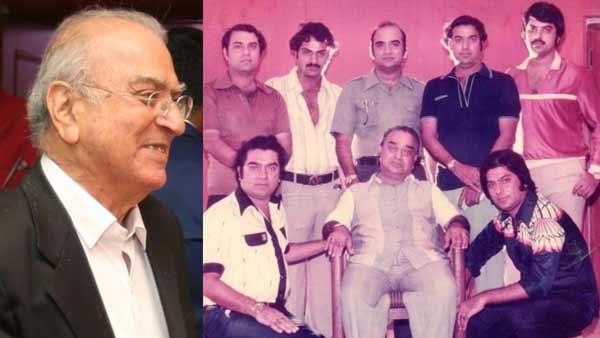
Note – Cinematographer means: Cameraperson
– He was 83 years old.
– He was struggling with health issues.
– He was quite famous for horror films.
– He was a part of the renowned Ramsay Brothers team.
– He passed away on April 7, 2024, in Mumbai.
About Gangu Ramsay
– Gangu Ramsay was one of the famous cinematographers and film producers in the renowned Ramsay Brothers, the second eldest son of F.U. Ramsay.
– F.U. Ramsay had seven sons: Kumar Ramsay, Keshu Ramsay, Tulsi Ramsay, Kiran Ramsay, Shyam Ramsay, Gangu Ramsay, Arjun Ramsay.
– Gangu Ramsay was a cinematographer.
– He did cinematography in more than 50 films.
– Some of his famous films include Veerana, Purani Haveli, Band Darwaza, Purana Mandir, Do Gaz Zameen Ke Neeche, Tahkhana, Samri, and more.
– His first film was ‘Do Gaz Zameen Ke Neeche’ (1972).
Ramsay Brothers
– Ramsay Brothers is a name used for a family of Bollywood film producers.
– They are famous for creating horror films.
They are seven brothers, and their father was F.U. Ramsay.
– That’s why they are called the Seven Ramsay Brothers.
—————
9. Tata Advanced Systems Limited (TASL) launched its sub-metre resolution optical satellite, TSAT-1A, from which rocket in April 2024?
a. GSLV
b. SLS
c. Falcon 9
d. LVM 3
Answer: c. Falcon 9 (built by SpaceX)
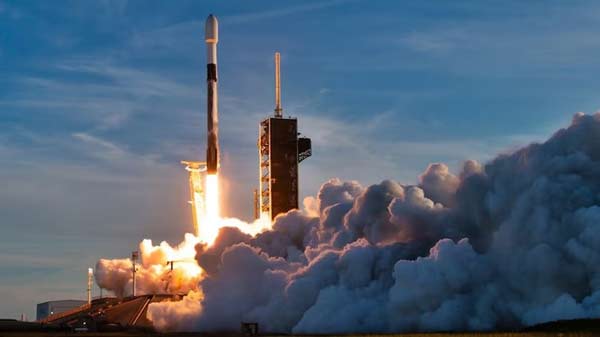
– Tata Advanced Systems Limited (TASL) announced the successful deployment in space shortly after the launch of the TSAT-1A satellite.
From which center was the satellite launched?
– The satellite was launched from the Kennedy Space Center, Florida, US, at 11:16 PM on April 7th (according to UTC Time).
– The satellite was deployed as part of the Bandwagon-1 mission into space.
The achievement was achieved with the help of which company?
– This achievement follows the cooperation signed between TASL and Satellogic Company in November 2023.
– This leverages Satelilogic’s expertise and TASL’s ability to perform complex system integration to develop and integrate an advanced Earth observation satellite in India.
How many spacecraft are there in the Bandwagon-1 mission?
– According to SpaceX, in addition to TSAT-1A, there were 11 other spacecraft in the Bandwagon-1 mission.
– Which includes Korea’s 425Sat, Hawkeye 360’s Cluster 8 and 9, Tyvak International’s Centauri-6, iQPS’s QPS-SAR-7 Tsukuyomi-II and Capella Space’s Capella-14 etc.
About the TSAT-1A satellite:
– It weighs 50 KG.
– It has been deployed in the lower Earth orbit.
– The satellite has a resolution capability of 0.5 to 0.8 meters.
– Which can be increased using software.
Tata Advanced Systems Limited (TASL):
– It is an Indian aerospace manufacturing, military engineering, and defense technology company.
– It is a wholly-owned subsidiary of Tata Sons.
TASL was established in 2007.
– The headquarters is located in Hyderabad, Telangana.
—————
10. When is World Parkinson’s Day observed?
a. 11 April
b. 12 April
c. 13 April
d. 14 April
Answer: a. 11 April
– Parkinson’s disease is caused by a disorder in the part of the brain that helps coordinate movement. It is a movement-related disorder. In this, the nerves that transmit signals from the hands or legs to the brain become impaired in functioning. This results in greatly reduced control over the hand.
– During Parkinson’s disease, people often become forgetful.
– This day marks the birthday of Dr. James Parkinson of London, who was the first person to systematically describe six individuals with symptoms of Parkinson’s disease.
– In addition, the month of April is celebrated as Parkinson’s Awareness Month.
PDF Download: Click here

